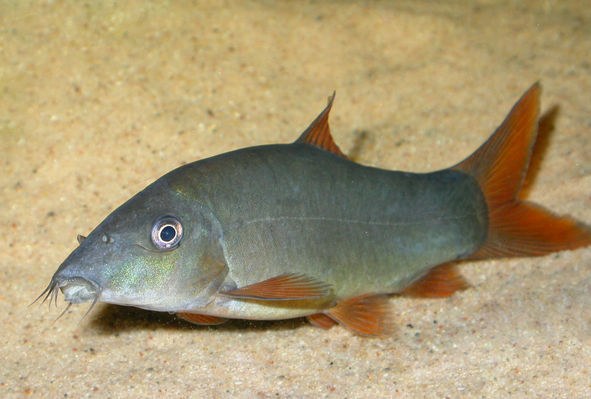Blue Botia (Yasuhikotakia modesta)
Summary
Scientific Name: Yasuhikotakia modesta (Bleeker, 1865)
Common name: Red-finned Loach, Blue Botia, Redtail Botia.
Synonyms: Botia modesta, Botia rubrippinis.
Distribution: Vietnam, Cambodia, Laos, Thailand.
Sexual Dimorphism: Females generally plumper all over than males.
Maximum size: 10 inches. More normally a max of 7" in aquaria.
Similar to: Yellow-finned populations can be mistaken for Yasuhikotakia lecontei.

Care: Due to its potentially large size and need for the company of its own species, a large tank is required with excellent filtration and regular water-changes.
Y. modesta are excellent diggers that appreciate a sand substrate to protect their delicate barbels. Lighting should be subdued.
 Feeding: Good quality flake, sinking pellets,
algae wafers, chopped earthworms, thawed frozen Bloodworm, Mysis Shrimp, chopped
Cocktail Shrimp. Avoid over-feeding as these fish are very greedy.
Feeding: Good quality flake, sinking pellets,
algae wafers, chopped earthworms, thawed frozen Bloodworm, Mysis Shrimp, chopped
Cocktail Shrimp. Avoid over-feeding as these fish are very greedy.
Water parameters: pH:6.5-7.5. Hardness: Medium. Max dh: 12
Temperature: 78.8ºF to 86ºF(26-30°C)
Breeding: Not bred in aquaria.
Notes
 Y. modesta is a heavily-built loach that
should be kept in a group of their own species. Like Clown Loaches, they have a
social structure and an "Alpha" loach will eventually lead the group. The fish
are highly territorial and a lot of in-fighting will be seen. During these
interactions and at feeding times, this species may be very vocal with its
clicking noises. Because of their territorial habits, provide numerous hiding
places so that less dominant fish may escape the attentions of more boisterous
individuals.
Y. modesta is a heavily-built loach that
should be kept in a group of their own species. Like Clown Loaches, they have a
social structure and an "Alpha" loach will eventually lead the group. The fish
are highly territorial and a lot of in-fighting will be seen. During these
interactions and at feeding times, this species may be very vocal with its
clicking noises. Because of their territorial habits, provide numerous hiding
places so that less dominant fish may escape the attentions of more boisterous
individuals.
Because of their size and temperament, Y. modesta should only be kept with other boisterous loach species, or large, fast moving, free-swimming fish such as large Barb species.
Body and fin coloration can be very variable in this species, probably due to the wide distribution in nature. Fins can be red, orange or yellow and body colour varies greatly, but is generally a blue-grey in colour, sometimes with a noticeable green sheen in certain lighting.
Mature, well cared for Y. modesta are extremely beautiful and impressive fish. It is unfortunate that part of the SE Asian exotic fish market feels the need to artificially enhance their appearance either by feeding color enhancing foodstuffs, dyeing, or at worst injecting color into the fish's skin.
 These two fish are sad examples of this
practice of artificial colouring. The colour is not permanent because if a dye
or injection is used the fish metabolize the dyestuff and often end up patchy
and unattractive. At worst, the injection sites may open the fish to
infestation with micro-organisms that can lead to infection and death. If
artificial color enhancing foods are used, the fish will revert to normal unless
fed this continuously.
These two fish are sad examples of this
practice of artificial colouring. The colour is not permanent because if a dye
or injection is used the fish metabolize the dyestuff and often end up patchy
and unattractive. At worst, the injection sites may open the fish to
infestation with micro-organisms that can lead to infection and death. If
artificial color enhancing foods are used, the fish will revert to normal unless
fed this continuously.
Loaches Online wholeheartedly abhors this artificial coloring practice and urges aquarists not to purchase such fish. Only by voting with our feet may we affect a change, and end this terrible practice.
For more information see: DeathByDyeing.org
Photo Gallery
Click to view all images of this species! |
|
Document Actions


